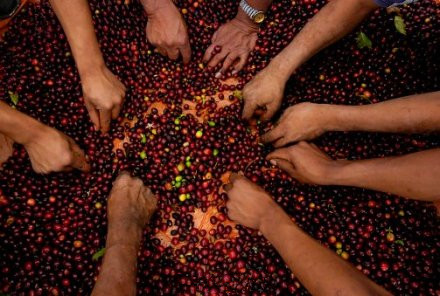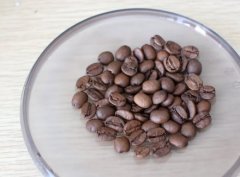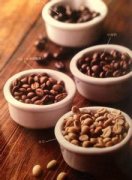High-quality coffee beans knowledge coffee ten kinds of defective beans
One of the most important factors affecting the quality of coffee is defective beans. The number of defective beans also affects the grade of coffee. For example, the coffee evaluation method used in Brazil is the "deduction method", which is graded according to the number of defective beans in 300 grams of staple beans per gram.

For example, coffee is hand-selected, so successful hand-selection is also necessary to have a comprehensive understanding of the types of defective beans. From this, we can see how important coffee defective beans are to coffee, but defective beans are only a general term, so how many kinds of defective beans are there? Please take a look at this article: how many kinds of coffee do you know?
First, shell beans
The endocarp of coffee covers the inside of the pulp of coffee beans and remains on the coffee beans treated by washing. The poor heat permeability when roasting and sometimes burning is the reason for the astringent taste of coffee.
Others include broken beans, red peeled beans (beans formed by rain in the process of natural drying, which taste dull and monotonous), stunted beans (small granulated beans that stop growing due to lack of nutrients, strong flavor), and sometimes mixed with corn kernels or pepper kernels.
2. Stone
The beans harvested are easy to be mixed with stone or sawdust because of the natural drying method.
Third, moldy beans
Because the drying is not complete, or in the transportation, storage process is too wet, and the growth of cyan, white mold, sometimes make beans stick together, if you do not remove these moldy beans, it will produce moldy smell.
4. Fermented beans
It is mainly divided into two categories: one is that the coffee is soaked in the fermentation tank for too long when the coffee is washed, and it is formed by the water pollution of the washed coffee beans; the other is the relationship of stacking in the warehouse, so bacteria are attached, and the surface of the beans becomes mottled. The appearance of fermented beans is not easy to distinguish, so special attention should be paid to hand selection. Fermented beans will smell rotten if mixed with coffee.
5. Dead beans
Beans with abnormal results. The color is not easy to change because of baking, so it is easy to distinguish. The taste is insipid, as harmful as silver skin, and will become a source of peculiar smell.
6. Unripe beans
The beans picked before they are ripe have a fishy and disgusting taste. Keeping coffee beans for several years is a countermeasure to deal with these immature beans.
Shell beans
Caused by poor dryness or abnormal hybridization; the bean breaks from the central line and the inside is turned out like a shell. Shell beans can cause uneven baking and are easy to catch fire during deep baking.
8. Worm-eaten beans
Moths invade and lay eggs when the coffee fruit ripens and turns red, and the larvae eat the coffee fruit and grow, leaving traces of moth on the surface of the beans. Moth-eaten beans can cause cloudy coffee juice and sometimes produce a strange smell.
9. Black beans
Beans that ripen and fall off early and ferment and blacken due to long-term contact with the ground. It can be easily selected by hand. Coffee mixed with black beans will smell rotten and turbid.
10. Cocoa
The reason for its formation is that the pulp remains and the pulp is not fully shelled by natural drying. With iodine, soil and other flavor, there will be a stink similar to ammonia. "Coco" means "dung" in Portuguese.
Important Notice :
前街咖啡 FrontStreet Coffee has moved to new addredd:
FrontStreet Coffee Address: 315,Donghua East Road,GuangZhou
Tel:020 38364473
- Prev

Standard for grading coffee beans
There are two ways to grade coffee beans, one is to filter the number of points, one is to elevation points. It is divided by the filter number and the size is determined by the mesh size. Round beans are generally smaller than flat beans, round beans between 8-13, flat beans between 12-29. 8,9,10... 12,13... 18... 29 = Small, Medium, Normal... It's a big... big, extra big. The bigger the number, the bigger the bean. Like SC
- Next

Coffee common sense factors to be considered when choosing raw coffee beans
The raw bean seller is mainly responsible for grading the coffee beans before selling them to the coffee bean merchant. After the grading is completed, premium coffee beans and boutique coffee beans will be selected, although they will have some defects but do not affect the coffee rating. These defects are not so serious, but they can also cause potential damage to the quality of coffee. Although Cupping is undoubtedly the most definite way to check coffee beans.
Related
- Beginners will see the "Coffee pull flower" guide!
- What is the difference between ice blog purified milk and ordinary milk coffee?
- Why is the Philippines the largest producer of crops in Liberia?
- For coffee extraction, should the fine powder be retained?
- How does extracted espresso fill pressed powder? How much strength does it take to press the powder?
- How to make jasmine cold extract coffee? Is the jasmine + latte good?
- Will this little toy really make the coffee taste better? How does Lily Drip affect coffee extraction?
- Will the action of slapping the filter cup also affect coffee extraction?
- What's the difference between powder-to-water ratio and powder-to-liquid ratio?
- What is the Ethiopian local species? What does it have to do with Heirloom native species?

